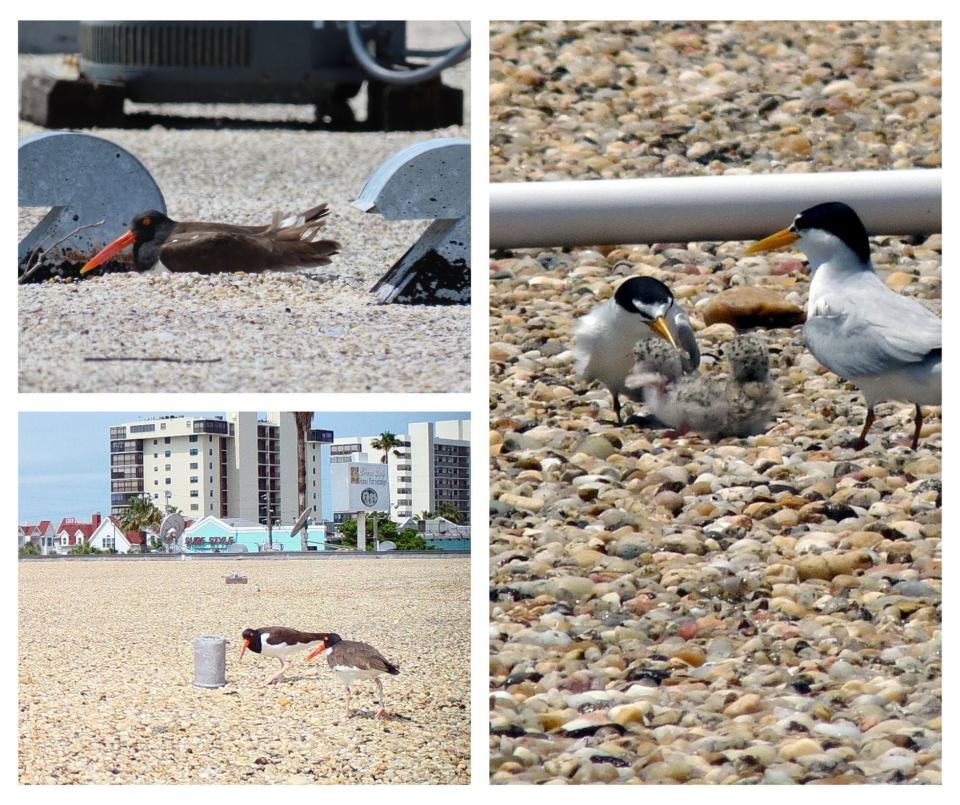Up on the roof: Here's how to protect seabirds and shorebirds' Jacksonville nests

Building owners in Northeast Florida's coastal areas are, in some cases unwittingly, providing rooftop-nesting habitat for seabirds and shorebirds.
The Florida Fish and Wildlife Conservation Commission recently issued a bulletin thanking building owners for the space and telling them what to do — and what not to do ― if they discover such temporary residents on their roofs.
The commission recommends, above all, giving the birds and their nests plenty of leeway and keeping them in mind when scheduling rooftop maintenance. Some of the birds are designated as protected species.
Here is some background on seabirds and shorebirds and how the commission recommends protecting their rooftop nests:
What's the difference between a seabird and a shorebird?
A seabird hangs around the ocean, foraging on open water. Shorebirds are found along the shore, foraging on beaches and nearby wetlands. But both nest on beaches, spoil islands and artificial habitats such as gravel rooftops, according to the University of Florida Extension Service.
Seabirds most commonly seen on Florida beaches are plovers, sandpipers and oystercatchers, according to Audubon Florida, while shorebirds include gulls, terns and black skimmers.
Why are seabirds and shorebirds using rooftops to nest?

They typically nest on beaches, but "as shorelines get busier, species such as black skimmers, least terns, roseate terns and American oystercatchers increasingly use gravel rooftops to nest and raise chicks," according to the commission. Building rooftops are mostly predator-free and provide important alternative nesting habitat, particularly critical for species that are endangered.
About 50% of Florida’s least tern population uses rooftops for nesting, the commission said.
"Habitat loss and degradation associated with coastal development has largely restricted many of these species to stretches of beach within parks and preserves," according to the commission. "This group of birds is particularly sensitive to human disturbance since environmental conditions on beaches are already harsh and unpredictable. For example, one dog passing near a colony of nesting seabirds can cause all the birds to panic and subsequently leave their nests dangerously exposed to the hot boiling sun."
So some of them head for rooftops to seek shelter from human and canine beachgoers.
When do seabirds and shorebirds nest?
Their nesting season in Florida varies by region but can begin as early Feb. 15 and run through Sept. 1. Most rooftop nesting is from April to September.
How can coastal building owners help the birds survive?
First, leave them alone. Removing eggs from a rooftop nest is illegal and likely fatal. Coordinate with the area regional shorebird biologist at myfwc.com/media/qvhp5oxt/shorebirdcountyassignments.pdf.
Conduct routine maintenance and nonemergency repairs outside of shorebird nesting season. If unexpected repairs are required during the nesting season, work with regional shorebird biologists.
Jacksonville Zoo on a mission: Conservation of wildlife and wild places at home and abroad
"Building owners and managers are key to the success of shorebirds nesting on rooftops," according to the commission.
Many building owners place signs to alert the public to rooftop nesting.
How can the public help nesting seabirds and shorebirds?

Here are a few tips from the commission:
Thank hotel and business owners, management and staff for supporting seabird and shorebird conservation.
Become a Qualified Rooftop Monitor, volunteers authorized to conduct surveys on whether a state permit is needed during work that could affect protected rooftop bird species. Lawful beach construction or development, significant habitat modification, special events with loud noise or activities may lead to "harm or harassment" of the birds. In such cases, the commission may issue a permit.
Do the "flock walk" when on the beach: Keep at least 300 feet away from nesting birds, walk around flocks of birds and avoid posted nesting areas. "Getting too close to nesting shorebirds, seabirds and wading birds can cause them to flush from their breeding sites, leaving vulnerable eggs and chicks exposed to the elements and predators."
Even well-behaved dogs can frighten the birds and possibly prompt them to abandon their eggs and chicks. Bring dogs only to beaches where they are specifically permitted and follow all leash laws.
Properly dispose of trash, including food scraps, which can attract bird predators such as raccoons and crows. Also, litter on beaches and in the water can entangle birds, turtles and other wildlife.
Be aware of posted Critical Wildlife Area closures on the beach or coastal islands — avoid them and keep noise down around them. These areas are closed to public access "to protect high concentrations of wading birds and shorebirds while they nest and raise their chicks."
For more information go to myfwc.com/conservation/you-conserve/wildlife/shorebirds/rooftop.
[email protected], (904) 359-4109
This article originally appeared on Florida Times-Union: Seaboards, shorebirds use coastal Jacksonville roofs for nesting
